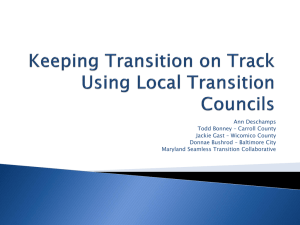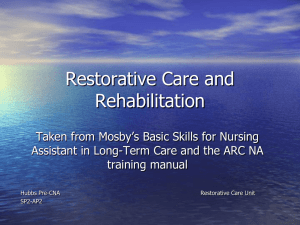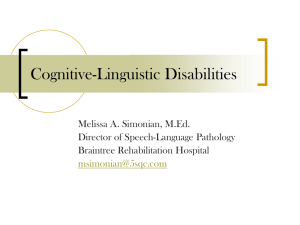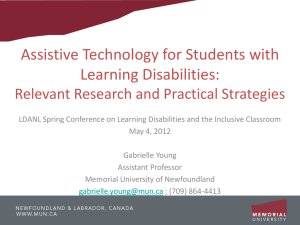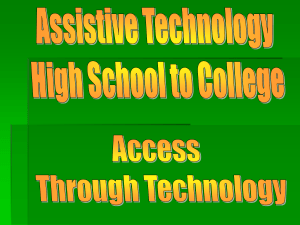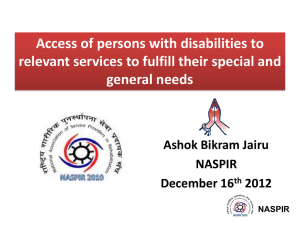DEPARTMENT OF MECHANICAL ENGINEERING
advertisement
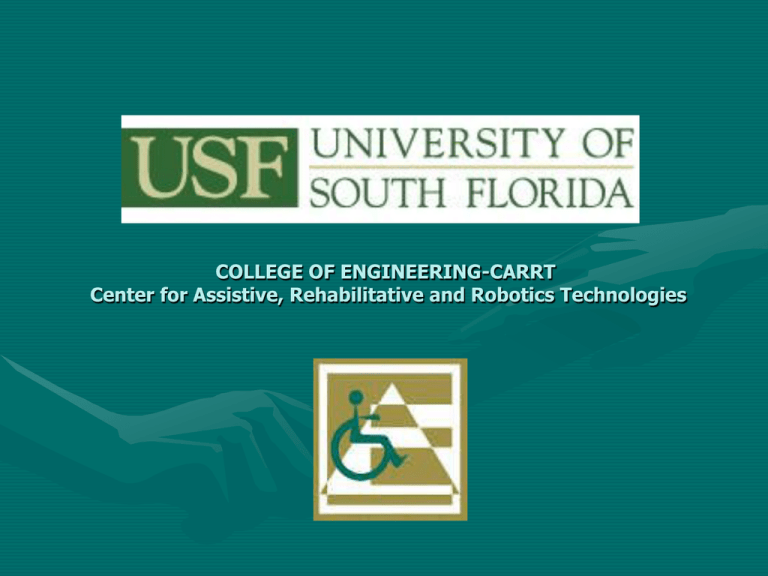
COLLEGE OF ENGINEERING-CARRT Center for Assistive, Rehabilitative and Robotics Technologies Name: Lexander A. Reina, MSBE, RET, ATP Tel: (305) 643-7495 Fax: (305) 643-7498 Email: lreina@usf.edu Education: BSE in Biomedical engineering from Tulane MSBE from University of Miami. Employed as a Rehabilitation Engineer serving VR clients since 1994, including almost 10 with the University of South Florida. Currently transitioning to supervise Statewide services. Private Consultant as Adapted for Access, Inc. providing assessments for other agencies. Licensed by the State of Florida as a Building Contractor and as a Professional Engineer. Certified by RESNA as both an Assistive Technology Practitioner and a Rehabilitation Engineering Technologist. REHABILITATION TECHNOLOGY SERVICE DELIVERY SYSTEM JACKSONVILLE (Zone 2) Santa Rosa Okaloosa Escambia Patti Barrett, RE Stephanie McGhee, Technician Holmes Jackson Walton Nassau Gadsden Bay Duval Baker Wakulla Gulf PENSACOLA (Zone 1) Leon Hamilto Madison n Suwanee Taylor Lafayette Clay Franklin Connie Pierson, Technician Alachua ORLANDO (Zone 4) Putnam Flagler Dixie Joshua Lujan, RE Vilma Cedoz, Technician TALLAHASSEE (Zone 1) Levy Marion Volusia Gary Sherman, RE Citrus Lake Seminole Sumter Hernando Orange Pasco Hillsborough TAMPA (Zone 3) Osceola WEST PALM BEACH Polk Indian River Stephen Sundarrao, Lead Engineer Bill Calvin, RE Manatee Linda Colon, Technician LEGEND Sarasota VR Customers per County Hardee Highlands St. Lucie DeSoto Charlotte < 100 Lee Martin Glades Hendry Palm Beach 100-500 500-1000 Collier Broward 1000-3000 Monroe > 3000 Dade MIAMI (Zone 6) Lex Reina, RE Alberto Garcia-Paz, Technician (Zone 5) Jeff Daniel, RE Lashara Thomas, Technician Integrated Model RESEARCH & DEVELOPMENT • Standards Development • Testing of Products • Technical Support to A & E ASSESSMENT & EVALUATION • Individualized Assessment • Coordination and Delivery of products/services • Qualification of Vendors/Service Providers EDUCATION/TRAINING • Rehabilitation Professionals • Vendors • Curriculum Development MARKETING / CUSTOMER SERVICES • Identification of Customer Needs • Quality Improvements • Outcome Measurements Schematic Representation Individual Interface Environment Disease Social Psychology Vocational Total Disability What is Rehabilitation Technology The 1992 Amendments to the Rehabilitation Act Defines Rehabilitation Technology as : “the systematic application of technologies, engineering methodologies or scientific principles to meet the needs of and address the barriers confronted by individuals with disabilities in areas which include education, rehabilitation, employment, transportation, independent living and recreation. The term includes rehabilitation engineering, assistive technology devices and assistive technology services.” What is Rehabilitation Engineering? Rehabilitation Engineering and Assistive Technology Society of North America • Rehabilitation engineering – the application of science and technology to improving the quality of life of people with disabilities. • Assistive technology (AT): – products, devices or equipment … that are used to maintain, increase or improve the functional capabilities of individuals with disabilities (1998 Tech Act) AT Goal is to be a Bridge Between the Individual with a Disability and their Environment Primary Users of AT • Congenital and/or developmental special needs conditions such as CP • Acquired disabilities due to accidental trauma, surgery, or illness such as amputees, SCI, BI • Progressive neurological, neuromuscular such as MS, MD, ALS • Temporary conditions such as Guillian-Barre syndrome, surgery, acute trauma • Aging population Assistive technology plays a critical role in the lives of people with disabilities. “If you were not able to use the assistive technology you use any more for some reason, how would this affect your daily activities?” 35% 26% 16% 16% 7% 6% 6% 2% Wouldn’t be able to take care of myself at home Wouldn’t be able to get around outside of my home Wouldn’t be able to attend social gatherings as often Would be less involved In hobbies/ interests Would be less productive at work Would lose access to information/ educational materials Note: The 2004 National Organization on Disability/Harris Survey of Americans with Disabilities Wouldn’t be able to keep current job Wouldn’t affect daily activities Reasonable Accommodations • • • • • Make existing facilities readily accessible Job restructuring Modifying work schedules Modifying equipment Developing custom aids and devices Range of Services We Provide • • • • • • • • Adapted Computers ** Communication Devices ** Work Site Assessments: Work Stations and Chairs** Wheelchair Assessments Home Modifications Lifts and Medical Equipment Vehicle Modifications OTHER Computer Use for Learning Disabilities • Reading Pen: • Digital book readers • Kurzweil 3000, WYNN, Read and Write Gold, Nuance Speak & See…all come from products for the blind. All based on document scan, OCR to text, then voice synthesizer reads. • Find the book on disk, call the publisher. Avoid the time consuming scanning. Voice Activation and Dictation • Dragon Naturally Speaking up to Version 11 • Windows Vista and 7 has included a pretty good one. • Not just for those who cannot type. Useful for students with grammar difficulties, as it is able to understand context and eliminate errors for some with disorders of written expression and other learning disabilities. Extra bundles help more (Speak and See). • Excellent means of transcription for the TEACHER to avoid need for note-takers. • Issues: Background Noise, voice quality, training… Induction Loop FM link (Can be hardwire) Receiver/Amplifier Telecoil on HA SPEECH AIDS Speech Easy: Choral speech device minimizes stuttering by fooling auditory centers into thinking others are speaking. Speech Enhancer: Augments low voice and can filter some dis-arthric speech. COMMUNICATION MOUSE ALTERNATIVES ADAPTED KEYBOARDS Computer Use for Learning Disabilities • Reading Pen: • Digital book readers • Kurzweil 3000, WYNN, Read and Write Gold, Nuance Speak & See…all come from products for the blind. All based on document scan, OCR to text, then voice synthesizer reads. • Find the book on disk, call the publisher. Avoid the time consuming scanning. Voice Activation and Dictation • Dragon Naturally Speaking up to Version 11 • Windows Vista and 7 has included a pretty good one. • Not just for those who cannot type. Useful for students with grammar difficulties, as it is able to understand context and eliminate errors for some with disorders of written expression and other learning disabilities. Extra bundles help more (Speak and See). • Excellent means of transcription for the TEACHER to avoid need for note-takers. • Issues: Background Noise, voice quality, training… VISUAL IMPAIRMENTS • Scan And Read Software Packages (JAWS, Kurzweil, Read & Write) • Magnification (Zoom Text) • Braille • IF AT ALL POSSIBLE, GET BOOKS ON DISK AND/OR AUDIO BOOKS INSTEAD!!! TEXT, TEXT, TEXT!!! Biggest issues I am called in on involve: 1. 2. 3. 4. Inability to write fast enough Note taking Participating in Class Reading and writing issues ALL MUST BE ADDRESSED BY DEALING WITH TEXT IN AND TEXT OUT ISSUES. IF UNIVERSAL DESIGN WAS APPLIED TO TRADITIONAL CLASSROOM INSTRUCTION… OTHER EXAMPLES OF OUR WORK: Custom Workstation to Increase Accessibility & ROM Currency Collection Device for use in a Drive-Thru Window MOBILITY INDEPENDENCE HEAD CONTROLS ALLOW FIRST TIME SELF PROPULSION FOR COLLEGE STUDENT WITH CEREBRAL PALSY STAIR CLIMBING WHEELCHAIR-iBOT Construction Modifications BATHROOMS & ROLL-IN SHOWERS KITCHENS ELECTRONIC AIDS TO DAILY LIVING: ENVIRONMENTAL CONTROLS LIFTS VAN CONVERSION FOR MEDICAL EQUIPMENT SUPPLIER WITH QUADRIPLEGIA VAN CONVERSION FOR PRINTING PRODUCTION MANAGER WITH LIMB-GIRDLE MUSCULAR DYSTROPHY Adaptive Driving High-Tech Driving USF: RESEARCH, REHABILITATION ROBOTICS & EMERGING TECHNOLOGIES Tricycle for a Quad Amputee Integration of R&D with Services HANDS-FREE WHEELCHAIR, SEGWAYS… "Hybrid Assistive Limb (HAL) 5," The robotic suit can give an average man twice his usual strength and was developed to assist the elderly in their everyday lives. Emerging areas for robotics The main emerging areas where robots have potential are in the – Home – Work – Medical field (Therapy, patient handling and monitoring) – Mobility and Transportation Raptor Manipulator • Price: $12,000. • It has 4+1 DOF. • It can lift up to 2.5 kg. • Because of its increased size, the range of the Raptor is 120 cm. • The first robot assistive manipulator that has gained FDA approval for use in the US. • The Raptor can be controlled using a keypad, a joystick, or even a sip and puff; enabling the user to control the Raptor even without limb control. Manus Manipulator • Price: $35,000. • It has 5+1 DOF. • It can lift up to 1 Kg. • The range is approximately 80 cm. • One of the first manipulators to have been developed in the late 1980s. • There have been several user trials and constant modifications and upgrades are being made to it. • The typical use is to retrieve items and bring them to the user, or put them elsewhere. Telerobotic Manipulation Q & A


